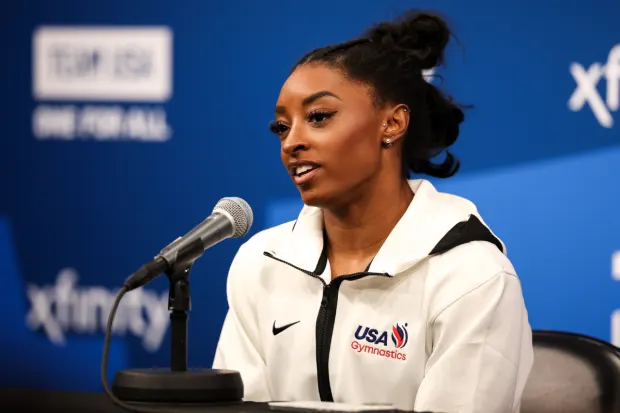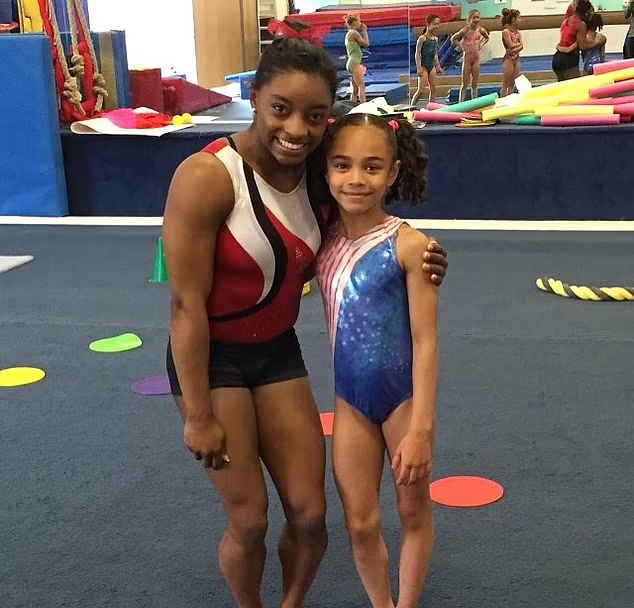The world’s best gymnast on disgraced US team doctor Larry Nassar, her year out and Tokyo 2020
Barack Obama with Biles at the White House, during a ceremony to honour members of the US Olympic teams.
Simone Biles, four-times world champion, winner of three individual Olympic gold medals and arguably one of the greatest gymnasts of all time, is 4ft 8in, but this is not how she appears when in flight. In the hangar-like space of the World Champions Center, a gym complex in a suburb of Houston, Texas, she stands at the end of a padded runway.
All morning, Biles has been hanging out with squad gymnasts, some as young as six, who are already training full-time at the facility and are so accustomed to seeing Biles, says her mother, they barely look twice.
(Occasionally, says Biles, “We’ll have a new kid come in and just stare. Other than that, it’s normal.”) For her part, Biles trains with the off‑hand style of the preternaturally talented, that almost louche kind of grace you see in top tennis players knocking up or sprinters stretching before a race, and behind which lies extraordinary powers. And then she starts running.
Last year, Biles returned to gymnastics after 12 months off and she is still adjusting to the demands of her schedule. After the training session, we sit in the office that overlooks the vast floor of the gym, Biles with a tracksuit thrown over her leotard, and talk about what it is like to be 21 and at the top of her game, the pressures of being the best in the world and just how Biles knows where she is when she’s airborne.
I started to realise that whenever I was having fun, I was performing better
At times, she seems younger than her years, a product of the almost religiously sheltered upbringing of the professional child athlete. At others, she sounds like a 45-year-old woman who should be running for political office. Biles swept the board at the World Gymnastics Championships in Doha last October and has had two moves named after her (“The Biles”) – one of which, on the vault, is described by the International Gymnastics Federation as a “round off flic-flac with ½ turn (180°) on stretched salto fwd with 2/1 turn (720°) off”.
Yet her appeal beyond the world of gymnastics – the reason I have heard so many women say, when her name comes up, “Oh my God, she’s amazing,” – is not just the physical and psychological courage necessary to excel at such a hard sport. What has become apparent, in the last year, is Biles’ moral courage. As an athlete, she is talked of in the same breath as Serena Williams, but the echo I find in her is of Muhammad Ali. In a sport whose governing body, USA Gymnastics, has been thoroughly disgraced by the conduct of its team doctor, Larry Nassar – currently serving a life sentence for sexually abusing young gymnasts in his care, including Biles – she will not bite her tongue. “It really has to be something that sets me off,” she says sheepishly, some way into our conversation. “But once I’m sure of something, I’ll go ahead and say it.”
It is a reminder, watching the morning training session, that competitive gymnastics is a strange world in which to immerse young children. Female gymnasts are said to peak in performance at 16, the minimum age at which they can compete at senior level events, including the Olympics.
Whereas male gymnasts bulk up with puberty and become stronger competitors, their female peers are generally considered more effective as children. “You want to be light in the gym, you want to be petite,” says Biles, who started relatively late, at the age of six.
“For females, once you go through puberty, you get a butt, you get boobs, and that makes it harder to do gymnastics because everything is going in different directions.” She laughs. The sobering thing is that, while 16 is the official peak age, in reality many female gymnasts are considered to peak at 12.
This is borne out by the scene at the World Champions Center, which is owned by Biles’ parents, Nellie and Ron. At one end, toddlers play with their parents in a baby gym area, while at the other, a coach drills tiny girls, many of them already ranked nationally, at work on the asymmetric bars. The air smells like every gymnastics centre in the world – of chalk dust and feet – and there are huge photos of Biles on the walls. “Good jig, but keep your head down, sweetie,” yells the coach at a tiny under-10. “Don’t pull the head! Elbows! Curve up through the butt! What are you doing with your legs? Work the curve! Curve! More! More! More!” The child dismounts, landing cleanly on her feet like a cat. “That’s so bad, Sophie. It’s not good at all. Your chest is like this the whole time.”
If I have kids, I’ll probably enrol them, in spite of the horror stuff that happened to me
I guess, I say to Biles later, the philosophy of prizes-for-all hasn’t reached competitive gymnastics yet? “No,” she says, smiling. Biles was introduced to gymnastics by chance, as a rainy day activity for a hyperactive six-year-old. She had recently moved to a suburb of Houston from her native Ohio and been adopted by Nellie and Ron, whom she calls mom and dad though they are technically her maternal grandparents. (Biles’ birth mother, Shanon, with whom she has minimal contact, struggled with addiction and was unable to care for her or her siblings. Her biological father, Kelvin, has never been a part of her life.) In the first instance, “it was just somewhere for her to climb safely,” says Nellie, a nurse who ran a consortium of nursing homes and knew nothing, at that point, about gymnastics. (She and Ron went into the gymnastics business after Biles won her first World Championship title in 2013.)
“I was just another little kid on the block who used to run and jump around,” says Biles. Soon after joining the gym, a coach observed Biles do a “seat drop” – a bounce from a sitting position back on to her feet, as if the floor were a trampoline, which six-year-olds shouldn’t be able to do. Biles’ upper body strength was so unusual, meanwhile, that while other kids flailed a few feet off the floor, she shot up a rope to the ceiling until everyone yelled at her to come down.
‘I was just another little kid on the block who used to run and jump around.’ Photograph: Dylan Coulter/The Guardian
In spite of all this, there was no thunderclap moment. “I was pretty young and I just knew that it was a lot of fun and I wanted to do it,” says Biles. “But it wasn’t that feeling of ‘oh-she-belongs-here’.” In fact it didn’t occur to her that she might have talent until she was 16, by which time she had risen up through regional competitions to the US Junior National Team and finally to the senior competition. Almost immediately, she won the women’s individual all-around event at the 2013 World Championships in Antwerp. But, I say with some incredulity, at 16 you were already operating at such a high level. Surely the realisation that you were good came earlier? “But once you get to a high level, there are still 100 other elite athletes. I wouldn’t say that I’m lucky but, if you look at it, there are hundreds of thousands of gymnasts in the US, and only four will make a team. So it’s almost like playing the lottery. You just never know.”
Like most professional athletes, she is incredibly hard on herself and competes less with others than with her own internal set of ideals.
In the past, Biles’ mother has tried gently to persuade her that she is almost always the best gymnast in the room, but this is not how Biles sees it. (This is, of course, the inverse of what one tells less-sporty kids, that it’s about doing their best in relation to their own goals. Apparently this doesn’t work with world champions.)
During those early years of competition, Biles, along with the rest of the women’s national squad, trained with Márta Károlyi, the then team coach and co-ordinator who ran training programmes at the Károlyi Ranch, a centre 50 miles north of Houston.
At home, Biles’ coach, Aimee Boorman, had always emphasised the importance of having fun while competing; but this was not the approach of Károlyi, a Romanian-American known for her unforgiving attitude and the inculcation of what one Olympic gymnast, Madison Kocian, described in the wake of the Nassar revelations as “a culture of fear, a culture of silence”. In Courage to Soar, the memoir Biles published in 2016, she recalls Károlyi telling her not to cheer for her peers at competitions and frowning on anything during training – laughter, for example – that might imply she was enjoying herself. She also urged Biles to attempt an excruciatingly difficult move on the vault, the Amanar, which involves two-and-a-half twists off the table, for the first time during a competition. In both cases – the demand not to laugh or cheer, and the request that Biles perform a move she felt was dangerous without adequate preparation – she pushed back against Károlyi.
“I started to realise that whenever I was having fun, I was performing better – so why stand there with a blank face?” says Biles. “Some people prefer not to talk during a competition, but we’re old enough to know what each of us needs.” After some resistance, Károlyi permitted Biles to emote as she wished.
As for the vault, “I knew that I wasn’t ready for it. You have to trust your body, your instincts. And you also have to protect yourself. If I could have done it and just fallen, then yes. But I would have done it and actually got hurt. So I was like, no, there’s no way.”
Even when I win, there are still times I’m upset. Like at Worlds. I fell twice. Yes, I still won. But it wasn’t my best
This was no small act of defiance for a teenage girl whose entire life was taken up by gymnastics. Biles attended an ordinary school until her early teens, when her training schedule became such that only homeschooling, on site at the gym, made sense. (Her short experience of high school was unhappy. “You’re at that age where there are boys in the class and you go to dances and I was obviously like,” her voice drops to a gutsy Mae West, “the strongest kid in my entire school. So I hid my muscles because the guys would stare and be like, ‘Oh my gosh, look at her muscles!’”)
Yet standing up to Károlyi wasn’t purely a question of confidence, says Biles. “It was more like protecting my body. This is about to end my career: why would I do this? Just go out there and kill yourself?”
What are the potential injuries if that particular move goes wrong? “ACL [anterior cruciate ligament] injury, MCL [medial collateral ligament or knee tissue] injury, basically anything. Who knows what I would have landed on?” She giggles. “I wasn’t ready for it.”
I’m curious about what this did to her trust in Károlyi. She shrugs. “It’s just because it was in a competition. If it was somewhere else I would have done it.” Didn’t she resent being asked in the first place? There is a long pause. “No,” says Biles, and there it is – the flash of what it takes to be the best in the world. “I already knew the answer. I wasn’t doing it.”
In January 2018, shortly before Larry Nassar was sentenced, Biles tweeted a statement in which she reported that, along with more than 160 other women, she had been sexually assaulted by the former national team doctor. “It is impossibly difficult to relive these experiences,” she wrote, “and it breaks my heart even more to think that, as I work towards my dream of competing in Tokyo 2020, I will have to continually return to the same training facility where I was abused.” Later that month, partly in response to Biles’ criticism, USA Gymnastics announced that no further training would take place at the Károlyi Ranch.
Nassar’s crimes shocked, both in scale – by some estimates, as many as 300 girls and young women were abused by him over a period of two decades – and audacity. He abused girls under the auspices of treating them for injuries, sometimes with a parent in the room. After Nassar was sentenced, the then-CEO of USA Gymnastics, Steve Penny, was arrested for evidence tampering, and the organisation – from which sponsors began to flee – stood accused of negligence at best, complicity at worst, in the way it had handled years of allegations.
Last October, when the acting CEO of USA Gymnastics, Mary Bono, tweeted a picture in which she covered up a Nike logo in protest against Colin Kaepernick’s Nike ad (the American football star had refused to stand for the national anthem in 2016) Biles pushed back. (Bono had previously worked for the law firm that represented USA Gymnastics, a firm that stands accused by some of Biles’ teammates of dragging its heels after the abuse was reported.)
“*Mouth drop*” tweeted Biles in response to Bono’s tweet, followed by: “Don’t worry, it’s not like we needed a smarter usa gymnastics president or any sponsors or anything.” After four days in the role, Mary Bono resigned.
“For us, it was about helping the athletes,” says Biles now. “We needed someone who would stand up for them, and you have to put aside your opinions if you’re going to come into an organisation that’s already failing. She chose to put her own opinions and beliefs before getting to know the team and I think that hurt us. Because we needed a sponsor and then she tweets out the Nike thing, and it’s like, ‘Well, that’s one of our top sponsors.’ So that wasn’t the smartest.”
To many observers, USA Gymnastics still appears to be failing. The entire board resigned after Nassar’s conviction, but there has still been no definitive account of how early the organisation knew about concerns surrounding him, and why nothing was done. Does Biles think there is work to be done, in terms of a forensic investigation into the organisation’s response?
Barack Obama with Biles at the White House, during a ceremony to honour members of the US Olympic teams,
“Well, I think so. But that’s [on] the head of our organisation and we can’t control that. Yes, we represent USA Gymnastics, but we can only do what we’ve been trained to do for so long. As athletes we are trying to be the best that we can, going out there and bringing back medals. That’s our job. The organisation has a different job.”
What do you do with the anger over having been failed, to that degree, by this organisation – one that owed you a duty of care?
“Yes, but I… ” Her eyes slide away. Biles bounced back so ferociously in competition last year, it is easy to forget how recent this all was. “What can you do at this point?” she says. Her mother Nellie, who has been sitting in, interrupts. “I don’t think that Simone analyses what goes on. And we don’t, as a family.”
They don’t? “No. We don’t analyse what the organisation does. And we acknowledge that they’re working on getting it right.”
“I feel like we’ve acknowledged that they failed,” says Simone, carefully. “And then we do what we do.”
There is little alternative if Biles is to hang on to her regard for gymnastics. “I feel like, if I have kids, I’ll probably enrol them, in spite of the horror stuff that happened to me. Because I know how much joy the sport has brought me.”
Was she ever in danger of losing that – of having gymnastics poisoned for her? “I go to therapy to help with that because there were times when I didn’t want to set foot in a gym. But am I going to let that keep me from my passion, and the goals that I still have? It’s just another bump you have to get over.”
Biles is strong and lucid as she talks about this, but her eyes are downcast and she directs her words to the floor.
Last year, Biles slammed her former teammate Gabby Douglas for urging women to minimise their risk of being sexually assaulted by dressing modestly. (Douglas later deleted the tweet.) “I think the statistics are, one in three girls [experience sexual assault],” says Biles. “That’s just ridiculous. You teach girls to cover up, rather than guys to not touch girls? They blame it on clothes, what the girls wear, she asked for it. Sorry – nobody asked for it. It’s never a girl’s fault and I think that’s the thing I had the hardest time understanding – that it wasn’t my fault.”
‘I just have very good air awareness.’ Photograph: Dylan Coulter/The Guardian
In 2016, Biles won four gold medals at the Rio Olympics, three individual and one team, tying her with four other gymnasts for the Olympic record for most gold medals won by a female gymnast in a single games. In 2018, after winning another world championship, she became the most decorated US gymnast in history. But, she says, “Even when I win, there are still times when I’m upset. Like at Worlds, last year. It doesn’t mean, because you win, you’ll be happy.” Why? “I fell twice. Yes, I still won. But I didn’t put out my best performance.”
The 2018 World Championships were Biles’ return to competition after a year out, which she took because, “I was so physically exhausted that I needed the break. Mentally and physically – I had earned it.”
During the hiatus, she took advantage of all the opportunities she’d had to turn down due to her training schedule. She took part in the television show Dancing With The Stars. She travelled extensively and collaborated on a book. She bought a house near her parents’ home in Houston. She didn’t miss the gym, she says, but when she came back, although she was “out of shape”, it was an effortless re-entry. “Everything came back pretty naturally because of muscle memory. After you do something for so long, it’s almost like riding a bike. Usually the only thing stopping you is fear.”
There are things Biles does in the gym that shouldn’t be physically possible. She stays in the air for what seems like minutes at a time. She flips and twists, yet somehow manages to land facing forward and knowing where she is. “I just have very good air awareness,” she says. “You can train on the trampoline to know where you are [in space], but I feel like it’s just sort of instilled in me. I’ve always been really good about knowing where I am and where my body is going.”
More than winning the Olympics, her dream was always to win a scholarship to college, specifically the University of California, Los Angeles (UCLA) and to compete on its gymnastics team. This sounds underwhelming for a record-breaking world champion, but after years of grinding competition on the international circuit, college gymnastics is, she says, where top-flight gymnasts go to kick back and enjoy themselves. She hopes that, after the 2020 Olympics, this may still be a possibility.
Does it give her vertigo to consider the fact that she is the best in the world? “I still think, to this day, ‘I’m not the best in the country: I’m the best in the entire world.’ And I’m like, whoa. It’s pretty ridiculous.” She bursts out laughing. “You can’t think about it too much or you’ll hurt yourself.” To resist the pressure, she reminds herself of something Mártha Károlyi told her. “She used to say, it doesn’t matter where you are or how many people are watching, it’s still the same routine you’re going to do. It helped me.”
And she is learning to give herself a break? Gymnasts are taught to compartmentalise and deny their own needs. “Emotions and hurting, you’re just taught to deal with it.” These days, Biles wonders if there might not be a better way to train. “If I’m not 100% in it, there’s no point in me coming in and pretending. Because what I do is dangerous – it’s high risk at this point. When you’re younger, you don’t have a choice: you go to the gym even if you’re sick. But if I’m feeling sick, why am I going to come in and torture myself?”
Sometimes, during her midday break, she drives home for a nap before the afternoon session. She gives a huge yawn. Such a schedule might seem intolerable but, “We’ve trained our whole life to do this. This is our normal.”
Earlier in the day, I watched as four men hefted a crash mat across the gym, a feat I had previously observed one of the tiny 10-year-old gymnasts, with Bilesian strength, achieve on her own. To one side, meanwhile, Biles was running the length of the runway. Pointing her toes, she sprang, rising to an elevation no human being should be capable of without a trampoline or jetpack. She flipped and twisted, and flipped and twisted again. Time slowed. In the air, she looked 10 feet tall.





